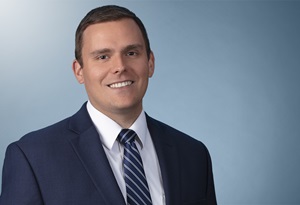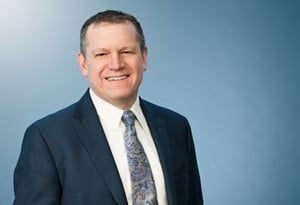Common Goals & Divided Government: Highlights From the 2019 NFI Insurance Public Policy Summit
The role of Big Data and how it’s revolutionizing the insurance industry was the focus of one of the 10 panel sessions at the recently held 15th annual Networks Financial Institute (NFI) Insurance Public Policy Summit in Washington, D.C., co-hosted by Faegre Baker Daniels and Indiana State University.
In addition to Big Data, this year’s summit covered a wide range of topics from innovation and regulation to consumer protection and retirement security. Below are highlights and photos from the NFI Summit presentations.
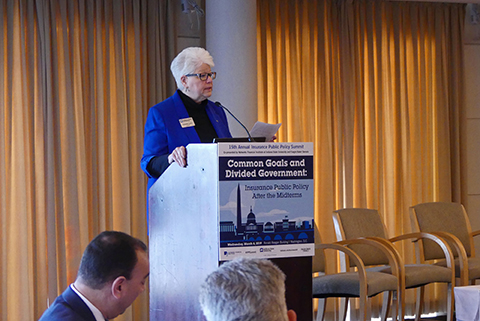
Deborah Curtis, Indiana State University President
Opening Remarks With District of Columbia Commissioner Stephen Taylor
In his opening remarks, Stephen Taylor, Commissioner of the District of Columbia Department of Insurance, Securities and Banking, stated that NAIC’s Life and Annuity (A) Committee, of which he is vice-chair, will continue its focus on annuity suitability and retirement security.
The priorities of District of Columbia regarding insurance are to support innovation and to attract financial institutions, the Commissioner said. He also spoke about the District of Columbia’s Innovation Council, which is currently discussing a possible regulatory sandbox, and he said that the Department is working to create a more regulatory friendly environment for captives.
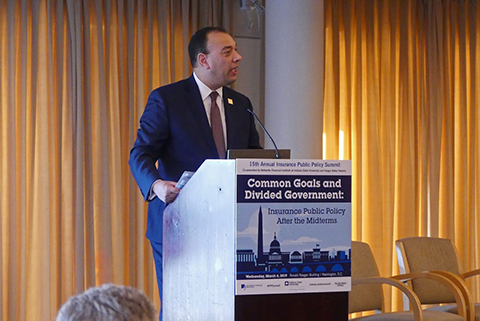
Stephen Taylor
Capitol Hill Perspectives
Rep. Brad Schneider (D-IL), who serves on the House Ways and Means Committee, discussed the crucial role of insurance for middle-income Americans and the safety net it provides.
Faegre Baker Daniels Consulting Principal The Honorable Luke Messer introduced the congressman.
In discussing the priorities of the House Ways and Means Committee, Congressman Schneider stated that:
- The Committee will focus on bipartisan issues, such as America’s deteriorating infrastructure.
- The Committee will also focus on the ever-increasing cost of prescription drugs and will explore common sense solutions to the problem.
- The congressman also discussed the Committee’s focus on trade and mentioned an upcoming hearing the Committee will be having with the U.S. trade representative Robert Lighthizer.
Congressman Schneider also emphasized that Congress will be focusing on issues important to the insurance industry, including retirement security.
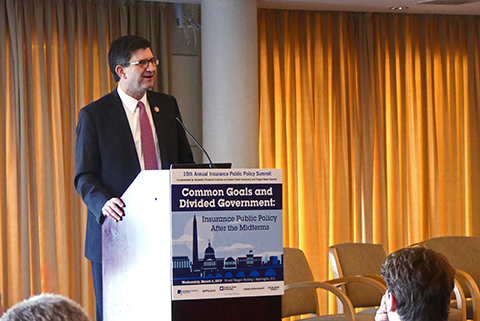
Brad Schneider
Team USA: Capital, ComFrame and Consultations in a Pivotal Year
Mike Consedine, CEO, National Association of Insurance Commissioners; Steven Seitz, Director, Federal Insurance Office, U.S. Department of Treasury; and Tom Sullivan, Associate Director, Division of Supervision and Regulation, Board of Governors, Federal Reserve System, covered a wide range of topics, including the IAIS’s Insurance Capital Standard (ICS) and Holistic Framework, the NAIC’s Group Capital Calculation, and the U.S. guaranty system. Moderator Roger Schmelzer, President, National Conference of Insurance Guaranty Funds, led the lively panel discussion.
Here are the highlights:
On the issue of group capital:
- The panelists highlighted the importance of this work stream both at home and abroad. Consedine emphasized that the NAIC’s group capital calculation will be a tool, not a prescriptive standard. Sullivan agreed that the U.S. calculation should be a tool and noted that the purpose of a capital calculation is to look across firms and regimes and identify outliers. Consedine and Sullivan highlighted the importance of the development of an ICS that achieves comparable outcomes across jurisdictions.
- Seitz argued that the ICS needs to be appropriately designed and suggested that the IAIS should build out parameters for the monitoring period. He also noted that he will continue to encourage the IAIS to move up the conversation on comparability.
On the U.S. guaranty system:
- Seitz noted the importance of the U.S. guaranty system being engaged on international issues and explaining our system to international regulators.
- Consedine agreed and noted that it is more important than ever to highlight that we have an effective safety net system. He argued that part of the reason U.S. companies do not need layers and layers of capital is because we have a guaranty system that works.
On the Holistic Framework:
- Seitz explained that FIO continues to be supportive of the switch from an entities-based approach to more of an activities-based approach.
- Consedine recognized that the Holistic Framework aligns closely with the NAIC’s macro-prudential initiative and suggested that this is an example of where the U.S. is out in front of international standard-setters.
- Sullivan argued that the U.S. does not want certain products to be looked at through a punitive lens, but it is the role of regulators to spot problem areas and put appropriate guardrails in place.
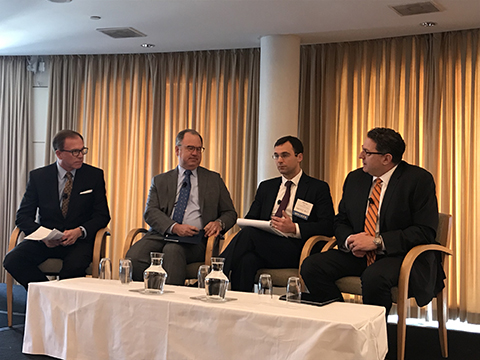
Roger Schmelzer, Mike Consedine, Steven Seitz and Tom Sullivan
Beyond the Hype: How Big Data Is Revolutionizing The Insurance World
Faegre Baker Daniels Partner Scott Kosnoff led an engaging panel of experts on how big data is revolutionizing the insurance world. The panel consisted of Jeff Beck, Senior Vice President, Government and Regulatory Affairs, Selective Insurance; Paige Freeman, Senior Vice President and General Counsel, Munich Re; Tim Jones, Director of Innovation, Transamerica and Jigar Gandhi, Faegre Baker Daniels Associate.
Each brought their unique perspective to discuss the types of data being collected, the benefits and concerns of collecting such data and how the industry will need to adapt. They also candidly discussed their concerns with the recent Insurance Circular Letter issued by the New York Department of Financial Services. Here are the key takeaways from the discussion:
- Whether benefits can outweigh the concern. Freeman recognized that, today, with concerns of the tech industry commoditizing data, we often overlook the benefits of collecting data. She noted that insurance companies are being careful when they collect data for underwriting purposes, ensuring they follow applicable laws. She also noted that in claims, data can be used to combat fraud. Despite credible reasons for collecting data, the panelists acknowledged concerns for ensuring that consumers are protected in the process. Gandhi noted that although plenty of data can be collected, it is a legitimate inquiry whether it should be collected and used. The panel also discussed the concern of algorithms in big data – even if companies don’t collect discriminatory information, they may need to consider risks related to liability for disparate impact.
- Importance of adapting to change. The panelists agreed that technology changes occur rapidly and, for companies to survive, they must adapt. Beck noted that with innovation occurring so quickly in the insurance industry, it is incumbent on insurers to anticipate where the market will go next. Jones compared the insurance industry’s challenges today with the retail industry’s challenges around 2008. When Amazon was gaining popularity, retailors needed to adapt to new technologies and start selling products online. Those companies that failed to adapt, just failed. Jones also mentioned that the tech industry has been trying to get into the insurance space for years but major barriers, including lack of knowledge and lack of legacy data, have largely prevented it. Thus, adapting to change will likely need to come from within the industry.
- New York Department of Financial Services Insurance Circular Letter No. 1 (2019). Kosnoff gave the audience an overview of the New York Department of Financial Services Insurance Circular Letter No. 1, issued on January 18, 2019, which generally (a) prohibits insurers’ use of an external data source, algorithm or predictive model that uses any prohibited factors, (b) requires insurers to independently determine compliance with anti-discrimination laws in underwriting and rating, and (c) imposes regulatory requirements with respect to adverse underwriting decisions. After Kosnoff asked for the panelists’ reactions, Freeman raised a few concerns. She noted the challenge insurers may have proving that certain outcomes are not discriminatory when they don’t collect or use any data that would violate any anti-discrimination laws. She also noted, and other panelists agreed, that the Circular Letter might place additional requirements on insurers when a consumer begins in an automated underwriting process but certain data entered causes the consumer to be “kicked out” to the traditional underwriting process. Such “kick out,” which serves to protect the consumer, could now be penalized. The panelists considered then whether the burdens of the Circular Letter might hurt New York consumers.
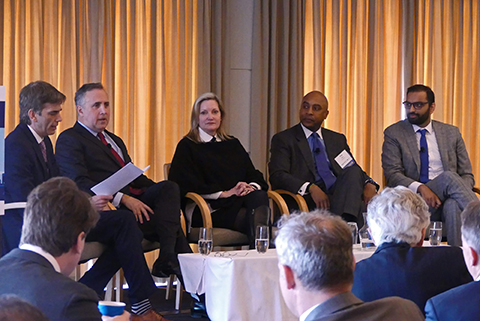
Scott Kosnoff, Jeff Beck, Paige Freeman, Tim Jones and Jigar Gandhi
FSOC at the Crossroads: A Conversation With the Independent Member
Thomas Workman was appointed as the Independent Member of the Financial Stability Oversight Council (FSOC) for a six-year term on March 29, 2018, after nomination by President Trump and confirmation by the Senate. Attendees at the summit heard a report from Workman on the activities of FSOC over the past year and the challenges that lie ahead.
After a brief introduction and context from moderator Peter Gallanis, President, National Organization of Life and Health Insurance Guaranty Associations, Workman provided the following report:
- Adoption of activity-based approach. Workman reported FSOC’s decision to propose an activity-based approach to identifying systemic risk and designating nonbank financial companies as systemically important. Workman referenced the U.S. Treasury Department’s endorsement of the activity-based approach in its report from November 2017. He also explained the benefits of such an approach, including the ability to look more broadly across the financial landscape and beyond individually large companies. Workman stated that FSOC will proceed to use an activity-based approach, and the entity-based approach when necessary, when considering financial stability and financial risk to fix problems in the financial markets before they get out of control. He also confirmed that FSOC will issue revised interpretive guidelines to implement the activity-based approach, alerting the crowd that such guidance could possibly be issued in the very near future. After Gallanis asked Workman about proportionality concerns in an activity-based approach, Workman acknowledged that the issue about whether smaller companies will be disproportionately burdened will likely come up in the process.
- “Excellent” relationship with NAIC. Workman touted FSOC’s relationship with the NAIC. He reiterated FSOC’s support, and the Treasury Department’s support, of the state-based insurance regulatory system.
- Cybersecurity task force established. Workman acknowledged that cybersecurity is a major challenge facing all industries. He reported that FSOC has developed a task force to fight cyber threats in the financial world.
- Looking ahead to Big Data. Lastly, Workman mentioned the concerns of big data and artificial intelligence leading to unfair discrimination. He recommended bringing your “very best thinkers” to the table for developing solutions.

Peter Gallanis and Thomas Workman
Life and Annuities: New Leadership for the Challenges Ahead
The newest life insurance trade organization CEOs, Wayne Chopus of the Insured Retirement Institute and Susan Neely of the American Council of Life Insurers, discussed their new roles and leadership in an evolving industry.
Led by New York Life’s Senior Vice President and Head of Government Affairs, Julie Herwig, Chopus and Neely outlined opportunities, threats, and priorities for their organizations and the life insurance industry generally. Several themes emerged, including:
- “We’re better together.” The regulation of life insurance is complex, which provides an opportunity and a need for increased communication among regulators, policymakers and industry professionals. Both Chopus and Neely emphasized the importance of collaborating, coordinating and partnering where possible with their peer associations on high priority issues. Chopus pointed to constructive engagement in particular – facilitating proactive discussions across all fronts to prevent detrimental consequences to consumers. Neely agreed and noted that advocacy among life insurance trades and organizations is critical to arming policymakers with the support they need to advance important legislation and regulations.
- Consumer protection. Both CEOs agreed that a patchwork of consumer protection laws/standards across the country is not beneficial. After the vacatur of the DOL Fiduciary Rule, proponents of the Rule took to the individual states, where there is currently an uptick in suitability and best interest activity. Neely commented that individual states are more of a hotbed of activity when the government is divided, and policy can’t be moved at the federal level. The CEOs are hopeful that the NAIC and the Securities and Exchange Commission (SEC) are putting forward process improvements that will provide assurance to consumers in regard to transparency and conflicts of interest, but that the playing field is getting increasingly complicated and harmonization is important.
- Retirement security. Chopus provided an alarming statistic that while 72 percent of American workers are concerned about retirement security, only about half of Americans have access to a retirement plan. Neely would like to see a national response/solution to the retirement security crisis, pointing to the Retirement Enhancement and Savings Act (RESA). The CEOs are both optimistic about RESA moving forward and have made it a priority to help drive that over the finish line.

Julie Herwig, Wayne Chopus and Susan Neely
A Conversation With NAIC President Eric Cioppa
John Huff, President and CEO of the Association of Bermuda Insurers & Reinsurers and former NAIC president, spoke candidly with new NAIC president Eric Cioppa, Superintendent, Maine Bureau of Insurance, about his first few months leading the NAIC and priorities for the year ahead. Faegre Baker Daniels Partner Pat Hughes provided the introduction.
Cioppa acknowledged the many new commissioners who came in after the midterms and recognized the NAIC’s proactive efforts to educate them about the NAIC and get them involved in key workstreams. Cioppa touched on several top-of-mind issues for the industry. Here are the highlights:
- Cioppa anticipated the newest version of the Credit for Reinsurance Model to be released shortly (that version is now exposed for comment). He stated that late comments received last year needed to be considered seriously, and changes will consist of both minor edits and more substantive changes. Recognition of group supervision and the group capital calculation will still be included.
- Moving to an activities-based-approach makes sense, and Cioppa believes the NAIC has recognized that through the macro-prudential initiative, but that “the devil is in the details.”
- The financial condition of the industry is very healthy. Cioppa applauded the industry’s resiliency and efforts to evolve financial infrastructure to ensure solvency across the markets.
- The lack of penetration in the flood market is a significant issue. According to Cioppa, the NAIC plans to partner with FEMA to increase outreach to consumers about the importance of flood insurance. He also indicated that the private market should be more involved in the issuance of flood policies, pointing to its ability to add coverage and increase innovation.
- Cioppa is taking a new approach to NAIC strategic priorities. This year, Cioppa worked with the Executive Committee to identify strategic priorities as they relate specifically to the NAIC’s letter committees. Here are a few:
- Life Insurance and Annuities (A) Committee: There are many competing interests regarding the Annuity Suitability Model. The NAIC is trying to get to a good place with the model, and the goal over the next year is to harmonize where possible with the SEC and the DOL.
- Health Insurance and Managed Care (B) Committee: Long-term care has been recognized by all members as a significant issue, which Cioppa emphasized needs to be resolved. He said the NAIC is establishing a committee to look at the issue more closely. Penn Treaty was referenced as a significant case study, and that balancing consumer and solvency needs is a necessity. Additionally, Cioppa recognized the need for market stability in health insurance and flexibility in the states. The NAIC will try to suggest solutions to Congress that may help, such as reinsurance, which could be good for the small group market.
- Property and Casualty (C) Committee: Climate risk and resiliency. The NAIC needs to focus on how to review solvency implications of recent and future catastrophes.
- Financial Condition (E) Committee: The NAIC will continue work on the macro-prudential initiative and the group capital calculation. MPI’s first focus will be on liquidity.
- Executive (EX) Committee: The three major cyber-related priorities here are 1) data protection – the NAIC is focused on doubling efforts to get the data security law passed, and addressing concerns with the variations in the models that are being passed; 2) big data – the NAIC needs to figure out what the appropriate guardrails are for carrier’s use of data; and 3) underwriting of cyber insurance – do carriers understand what they’re writing?

Eric Cioppa and John Huff
Politics and Policy: Intersection of Federal and State
In a discussion moderated by Faegre Baker Daniels Partner Alison Watson, Ben Moss, Vice President of Government Relations, Guggenheim Insurance, and Dean Pappas, Vice President, Federal Legislative & Regulatory Affairs, Nationwide, discussed the following topics:
- On how the insurance industry should engage new members of Congress:
- Pappas discussed the critical importance of educating new members of Congress. Pappas mentioned that the insurance industry is misunderstood on Capitol Hill and that positioning the insurance industry as a resource to Congress is key.
- On the turnover of Insurance Commissioners and state action:
- Moss discussed the considerable turnover of state Insurance Commissioners and also stressed the need to educate state employees on the nuances specific to insurance.
- Moss also discussed how critical it is for the insurance industry to attend events held at state insurance departments in order to engage regulators and learn about priorities.
- Pappas discussed how states are acting on critical issues such as privacy and suitability because there is not much action on those issues in Washington.
- During the panel, Rep. French Hill (R-AR) also commented on potential actions by the House Financial Services Committee:
- Congressman Hill stated that he hopes that the House does not relitigate TRIA.
- Congressman Hill also said that he hopes that the Committee can find a permanent solution for the National Flood Insurance Program.
- Congressman Hill then asked the panel about international standards and how they impact the U.S. insurance market and specifically mentioned Federal Reserve vice-chair Randy Quarles’ position on the FSB. Pappas said in addition to educating Congress, it’s crucial to educate the Federal Reserve on insurance issues.
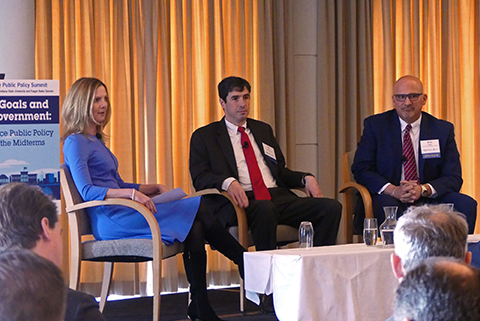
Alison Watson, Ben Moss and Dean Pappas
Property and Casualty: Critical Issues in 2019
David Sampson, President and CEO, American Property Casualty Insurance Association, and Brady Kelley, Executive Director, Wholesale & Specialty Insurance Association, provided updates on the smooth transitions of their respective organizations.
Then Deirdre Manna, Senior Vice President, Head of Government and Industry Affairs, Zurich North America, led a discussion that included Sampson, Kelley and Chuck Chamness, President and CEO, National Association of Mutual Insurance Companies, that centered on flood insurance, the Terrorism Risk Insurance Act, and innovation and technology.
Here are the major takeaways:
- The panelists outlined their priorities for 2019. In addition to the obvious suspects (Covered Agreement implementation, group capital, etc.), Chamness noted that NAMIC will work on helping state regulators improve financial and market conduct examinations. Sampson explained that long-term re-authorization of the NFIP and TRIA are major priorities for APCIA. Kelley also noted the importance of a re-authorization of flood and explained that WSIA would like to see movement on the National Association of Registered Agents and Brokers (NARAB).
- The panelists seemed united in their desire to see a long-term reauthorization of the NFIP; Sampson suggested reforms in the form of enhanced resiliency and mitigation provisions.
- On the issue of technology and innovation, Chamness noted that the highly regulated aspect of the insurance industry means that innovation in the insurance industry moves at a measured pace. Sampson highlighted privacy as an area that will continue to attract attention from regulators and policymakers.
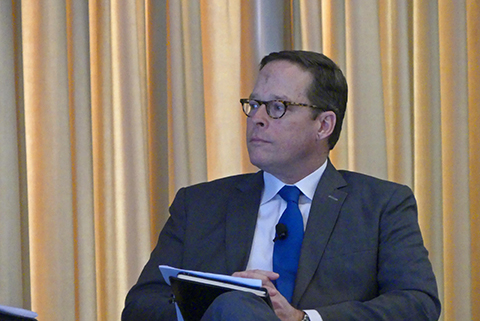

Charles Chamness, Deirdre Manna, David Sampson and Brady Kelley
Federal Judicial Outlook: Appointments, Philosophies and Potential Impacts
After an introduction by Peter Gallanis, Eugene Scalia, a partner in the D.C. office of Gibson Dunn, closed the summit with a captivating analysis of the direction of the federal courts, moderated by Ann Kappler, Senior Vice President, Deputy General Counsel and Head of External Affairs, Prudential.
Scalia addressed a wide range of topics, including similarities among the president’s appointees to the federal courts, the importance of the U.S. Court of Appeals, and an increased attention to regulatory issues. Here are the highlights:
- On recent appointments to the federal courts:
- Scalia opened by noting both the significant number of appointments this president has made to the Court of Appeals and the speed by which they have been filled.
- He observed several commonalities of judicial philosophies among recent appointees, including: originalism (interpreting the Constitution based on its meaning at the time it was ratified), textualism (interpreting statutes and regulations based on text and without reference to external sources such as intent) and a cautious attention toward the regulatory state. Scalia also noted that recent appointees have been relatively young.
- On the Court of Appeals:
- Scalia acknowledged the great importance of the Court of Appeals, due to the difficulty of a case making its way before the Supreme Court. While the Supreme Court takes cases reflecting sharp disagreement in the application of the law among lower courts or issues of public importance, the final decision in most cases is issued by the Court of Appeals.
- Focus on the regulatory state:
- While Scalia acknowledged the difficulty of predicting the big issues in store for the future, he predicted the president’s appointments to the federal judiciary will be giving increased attention to administrative law issues. Justices Gorsuch and Kavanaugh, for example, have both expressed interest and opinions in this area of law.
- Of particular interest to regulated industries, he noted the Supreme Court will hear arguments in Kisor v. Wilkie later this month. This is a case to follow, as it could reshape the deference afforded by courts to agencies that interpret their own ambiguous regulations. Although the case concerns a federal agency, its outcome could influence state courts and thereby impact entities regulated at the state level.
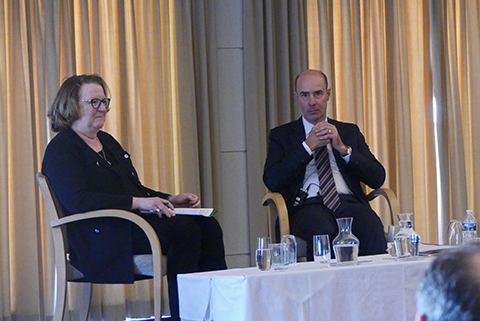
Ann Kappler and Eugene Scalia


